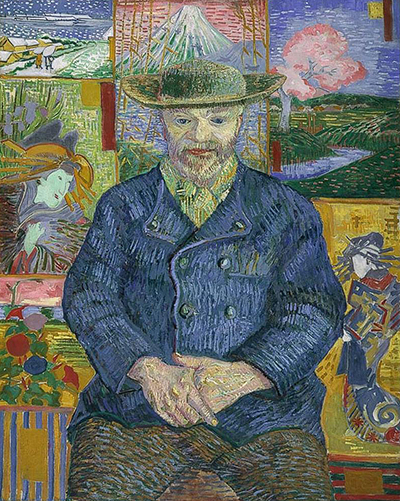In 1887, Van Gogh painted the picture of Julien Tanguy, with whom they had become good friends. The image was one of the three he painted of his friend Tanguy during his stay in Paris.
However, all three paintings were not similar in artwork because he was trying to taste and demonstrate the different artistic styles used in Paris in each of them. The first picture portrays realism style, mostly brown, wearing his green apron and a touch of red on his lips. Victoria Finlay, a writer, describes Tanguy's image to be looking more of a Buddha than an artist in the portrait. In the second one, he used impressionism and used pointillism style in the third one. In his second and third portraits, he painted him sitting, and behind him, there is a very colorful wall of Japanese prints.
The second picture was preferred because it represents Pere Tanguy's character and traits. It shows his calmness, cordial confidence, stoicism, and the goodness of his nature. Other features in the picture are his small eyes that were always full of emotion and showed no trace of malice. Pere Tanguy was a very well-known figure and had a small paint store at Rue Clauzel, where he sold paints, brushes and paintings. He bought van Gogh paintings and later sold them at a profit to make a living.
In the second picture, Van Gogh used pure colors that are contrasting with complementary colors. Other visible features include the well-placed brushwork and flat space in the image that portrays his neo-impressionist artistic style. Van Gogh's painting depicts Pere Tanguy in a stern frontal pose, lost in thoughts, immobile, and holding his hands over his stomach. He well captures the sitter's kindliness and self-consciousness. On top of the hat, there are Mount Fuji and Kabuki actors that share the wall prints with cherry trees.
Van Gogh moved from the Netherlands to Paris to live with Theo in 1886. Theo was his brother and a Parisian art dealer, and this brought about Van Gogh's exposure to symbolists, Japanese art, pointillists, and impressionist's art. Japanese ukivo-e artists, Hokusai and Hiroshige, were the great influencers of Van Gogh artwork, whose artworks reflected a style of flat colored patterns with no shadow.
In the time that he lived in Paris, van Gogh used various types of painting styles and finally came up with his unique styles that inspired other artists like his friend Émile Bernard, who was both a writer and a painter. Pere Tanguy kept his portrait all his life, but after his death, his daughter sold it to sculptor Auguste Rodin. The picture, previously in Rodin's collections, is held at the Musee Rodin in Paris.




